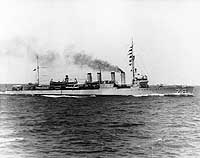
USS Philip, a 1060-ton Wickes class destroyer built at Bath, Maine, was commissioned in August 1918. During the remaining months of World War I she performed convoy escort and antisubmarine duties between the U.S. and Europe. In May 1919 Philip was one of several destroyers that supported the trans-Atlantic flight of the flying boat NC-4. The following July she transited the Panama Canal to take station in the Pacific, where she served until placed out of commission at San Diego, California, in late May 1922.
Recommissioned in February 1930, Philip operated with the Battle Fleet in the Pacific and later in the year steamed to the Atlantic for employment with the Training Squadron. During the first months of 1932 she was active off Central America with the Special Service Squadron and in August rejoined the Battle Fleet. She operated in the Pacific for nearly five more years, until decommissioning for a second time at San Diego in April 1937.
As with many of her sister "flush-deck" destroyers, Philip was placed back in commission in September 1939, soon after World War II broke out in Europe. From late in 1939 until July 1940 she served in the West Indies and Caribbean areas, helping to enforce the United States' neutrality in the great conflict. In October 1940 USS Philip was decommissioned at Halifax, Nova Scotia, and transferred to Great Britain as part of an agreement that gave the British fifty badly-needed destroyers and gained Western Hemisphere bases for the U.S. As HMS Lancaster she served in the Royal Navy until 1945. The old destroyer was scrapped in 1947.
USS Philip was named in honor of Rear Admiral John W. Philip (1840-1900), who served in the U.S. Navy from before the Civil War until the beginning of the Twentieth Century.
This page features all the views we have related to USS Philip (Destroyer # 76, later DD-76).
| If you want higher resolution reproductions than the digital images presented here, see: "How to Obtain Photographic Reproductions." |
Click on the small photograph to prompt a larger view of the same image.
|
Photo #: NH 42613 USS Philip (DD-76) In port, during the 1930s. U.S. Naval Historical Center Photograph. Online Image: 74KB; 740 x 595 pixels |
 |
|
Photo #: NH 75533 USS Philip (DD-76) Underway during the 1930s. Courtesy of the Naval Historical Foundation, 1972. U.S. Naval Historical Center Photograph. Online Image: 82KB; 740 x 510 pixels |
 |
|
Photo #: NH 95792 Trans-Atlantic Flight of the "NC" Aircraft, May 1919 Diagram of the third leg of the flight of the NC-1, NC-3 and NC-4 aircraft, between Trepassy Bay, Newfoundland, and the Azores, during 16 May to 20 May 1919. It also shows the positions of the 21 U.S. Navy destroyers stationed along the way. Printed by the Matthews-Northrup Works, Buffalo, New York. U.S. Naval Historical Center Photograph. Online Image: 109KB; 900 x 605 pixels |
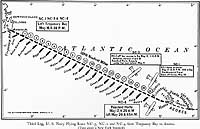 |
|
Photo #: NH 42536 Destroyers in the Middle Chambers, Gatun Locks During the Pacific Fleet's passage through the Panama Canal, 24 July 1919. Those in the front center are (left to right): USS Yarnall (Destroyer # 143) is by herself just aft of that group. Partially visible at right are (left to right): Two of the three ships just astern of that group are: Photographed by the Panama Canal Company (their photo # 80-C-5). U.S. Naval Historical Center Photograph. Online Image: 126KB; 740 x 565 pixels |
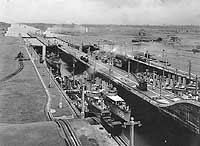 |
|
Photo #: NH 57141 Destroyers in the Upper Chambers, Gatun Locks During the Pacific Fleet's passage through the Panama Canal, 24 July 1919. Those present are: U.S. Naval Historical Center Photograph. Online Image: 103KB; 740 x 555 pixels |
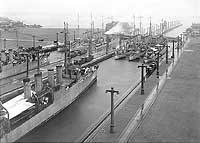 |
|
Photo #: NH 98487 Thirteenth Destroyer Division Officers & Crews on board their ships in San Diego Harbor, California, 6 December 1919. Signalmen are sending semaphore messages from atop the ships' bridges. Panoramic photograph by O.A. Tunnell, Masonic Temple Building, San Diego. Ships present are (from left to right): Upshur (Destroyer # 144), Greer (Destroyer # 145), Elliot (Destroyer # 146), Aaron Ward (Destroyer # 132), Buchanan (Destroyer # 131) and Philip (Destroyer # 76). Donation of Captain W.D. Puleston, USN (Retired), 1965. U.S. Naval Historical Center Photograph. Online Image: 107KB; 1200 x 275 pixels |
|
|
Photo #: NH 98029 "Old Hen and Chickens" USS Kanawha (AO-1) with thirteen destroyers alongside, off San Diego, California, during the early 1920s. Photographed by Bunnell, 414 E Street, San Diego. Ships present are identified in Photo # NH 98029 (complete caption). Collection of Chief Quartermaster John Harold, USN. U.S. Naval Historical Center Photograph. Online Image: 86KB; 740 x 465 pixels |
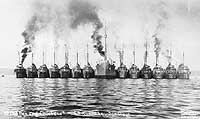 |
|
Photo #: NH 42539 "Red Lead Row", San Diego Destroyer Base, California Photographed at the end of 1922, with at least 65 destroyers tied up there. Many of the ships present are identified in Photo # NH 42539 (complete caption). U.S. Naval Historical Center Photograph. Online Image: 159KB; 740 x 515 pixels |
 |
|
Photo #: NH 70793 (cropped) Destroyers at the Mare Island Navy Yard, California, 11 April 1930 These ships are (from left to right): USS Badger (DD-126); USS Claxton (DD-140); USS Philip (DD-76); USS Broome (DD-210); and the stricken Corry (ex DD-334), which is being scrapped. This view is cropped from Photo # NH 70793. Courtesy of the Mare Island Naval Shipyard, 1970. U.S. Naval Historical Center Photograph. Online Image: 105KB; 740 x 585 pixels |
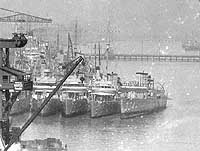 |
|
Photo #: NH 74288 USS Philip (DD-76) Ship's officers and crew, posed on her foredeck during the 1930s. A small photograph of the ship is inset in the upper left. Courtesy of the Naval Historical Foundation, 1971. U.S. Naval Historical Center Photograph. Online Image: 93KB; 740 x 450 pixels |
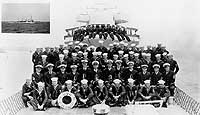 |
In addition to the views referenced above, the National Archives appears to hold at least one other photograph of USS Philip (Destroyer # 76). The following listing describes this image:
The image listed below is NOT in the
Naval Historical Center's collections.
DO NOT try to obtain it using the procedures described in our
page "How to Obtain Photographic Reproductions".
|
USS Philip (Destroyer # 76) at rest or underway a low speed in Hampton Roads, Virginia, 19 July 1919. Starboard broadside high aerial view, somewhat toward the bow. Reproductions of this image should be available through the National Archives photographic reproduction system for pictures not held by the Naval Historical Center. The image listed above is NOT in the Naval Historical Center's collections. DO NOT try to obtain it using the procedures described in our page "How to Obtain Photographic Reproductions". |
| If you want higher resolution reproductions than the digital images presented here, see: "How to Obtain Photographic Reproductions." |
Page made 11 July 2003